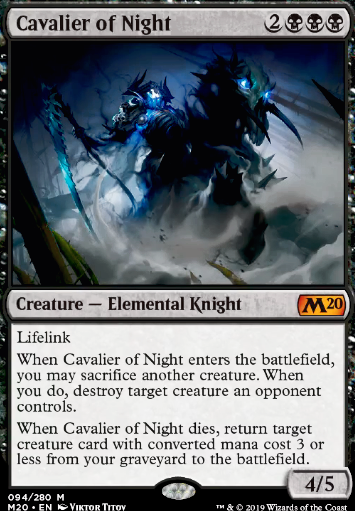By combining two
Mirror Image
s and a
Cavalier of Night
, you can destroy every non-hexproof, non-indestructible creature your opponent controls. This is done by copying a Cavalier of Night with a Mirror Image while the other Mirror Image is either in your hand or in your graveyard. If the second Mirror Image is in your graveyard, you simply sac the real Cavalier to the Mirror Image's Cavalier ETB (enters the battlefield) trigger, destroying a creature your opponent controls. When the Cavalier dies, use its death trigger to return the second Mirror Image from your graveyard to the battlefield copying the first Mirror Image, giving you yet another Cavalier of Night. Sacrifice the first Mirror Image to the second one's ETB trigger to destroy another creature your opponent controls. This time, use the death trigger of your Mirror Image/Cavalier of Night to return the very Mirror Image that just died to the battlefield. Now your Mirror Images can cyclically sacrifice themselves to each other and reanimate themselves until you've destroyed all your opponent's vulnerable creatures.
The combo doesn't end here, however. Due to the way
Cavalier of Night
's ETB ability is worded, you do not require a target in order to sacrifice a creature to it, meaning you're able to continue cycling through the sacrificial loop of Mirror Images copying Cavaliers indefinitely.
Cavalier of Night
's ETB ability is also optional, meaning you're allowed to stop the loop whenever you choose. In short, the combination of two
Mirror Image
s and a
Cavalier of Night
gives you as many ETB and death/sacrifice triggers as you want. This deck used to combine this loop with
Poison-Tip Archer
for infinite damage, but I've swapped it for a singleton copy of
Nexus of Fate
for infinite turns instead.
How do you get infinite turns out of a single Nexus of fate and unlimited ETB/death triggers? With a
Risen Reef
in play, the indefinite ETB triggers you get out of the loop give you a Risen Reef trigger every time you return a Mirror Image to play copying Cavalier of Night because
Cavalier of Night
is an elemental creature. This means that you can put every land card from your library into play tapped and every other card in your deck into your hand when you get the Mirror Image/Cavalier of Night combo off in one turn. In doing so, you are guaranteed to find your
Nexus of Fate
and, if you can't afford to cast it, will at least be discarding it to hand size at end of turn, which will shuffle it into your now 1-card library. Given that every land in your library will at this point be on the battlefield, you'll have no problem casting Nexus every turn, giving you infinite turns for the rest of the game.
This deck is capable of holding its own even when it's not comboing off. Usually, when you do initiate the infinite turns combo, it's for one of three reasons: 1) You managed to assemble it very early in the game due to good RNG, 2) You found yourself in a tough spot and you were forced to go for it because it was the only conceivable line of play that could have won you the game, or 3) You do it even while you're ahead, not because you need to do it to win, but to insure against your opponent top-decking like Yugi Mutou.
The third option really isn't that uncommon because of the snowballing value provided by your Risen Reefs (and
Mirror Image
s copying Risen Reefs) in conjunction with your other value-generating cards. There are several plays you discover while piloting this deck that exemplify this.
Neoform
ing a
Cavalier of Night
into a
Muldrotha, the Gravetide
when you have a
Risen Reef
in your graveyard (or using
Blood for Bones
on a Cavalier in the same situation), for example. Not to mention that even when you don't have the combo assembled, it can still be reasonable to copy a
Cavalier of Night
(or
Ravenous Chupacabra
) with a
Mirror Entity
to rid your opponent's board of legitimate threats.

